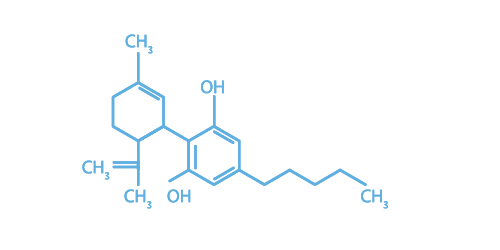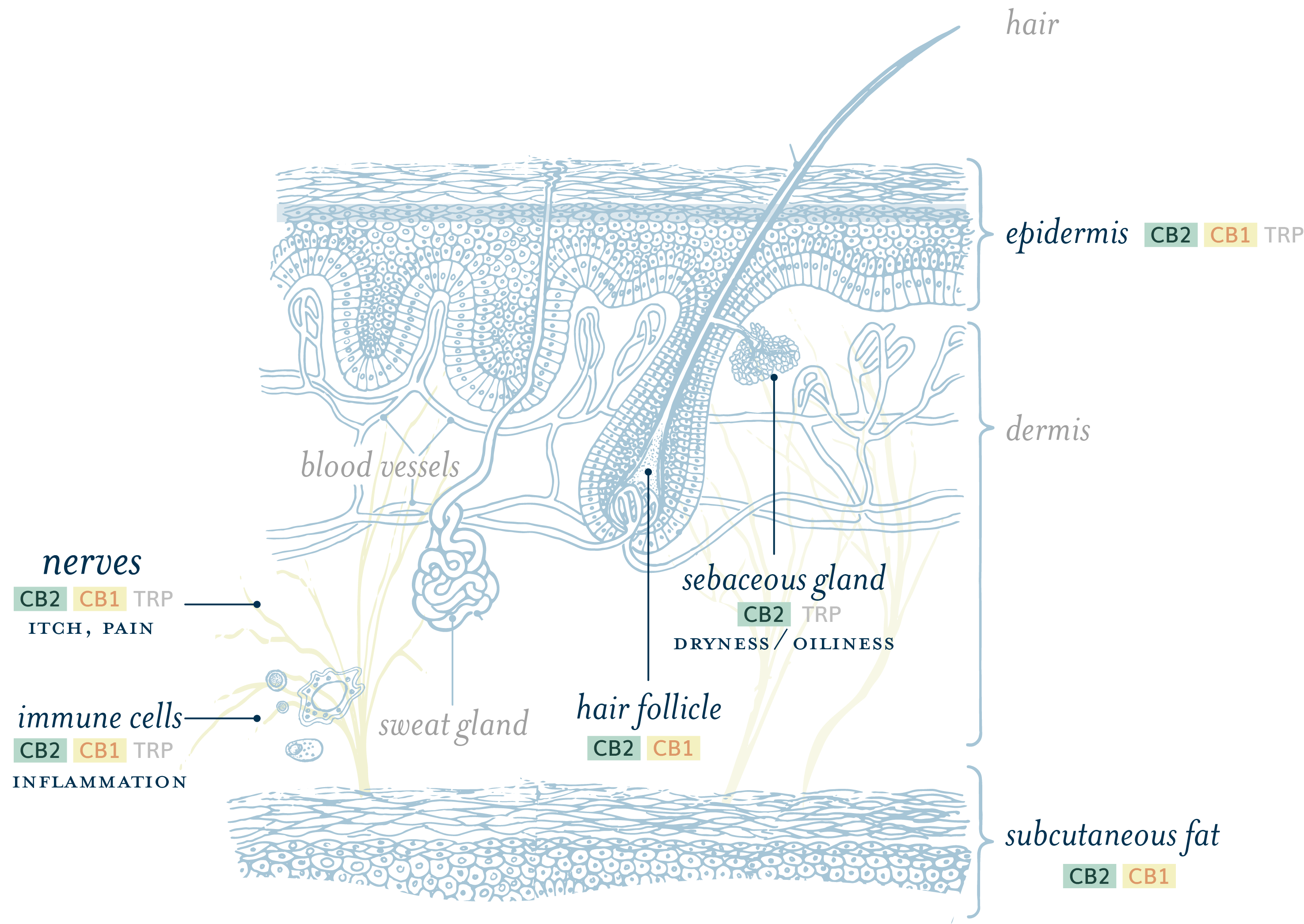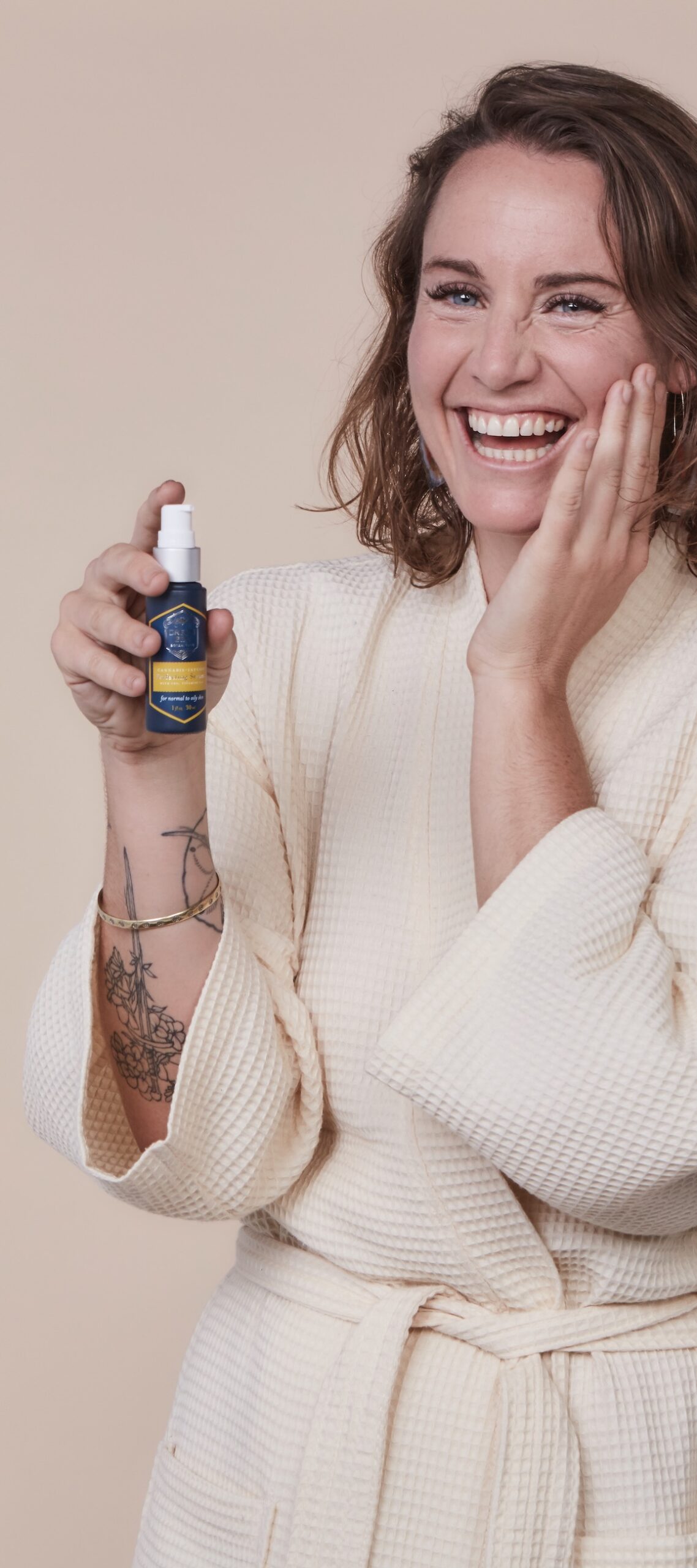The Human
Endocannabinoid
System
Your body’s most important system (that you’ve probably never heard of)
What is the endocannabinoid system? Often referred to as the ECS, the endocannabinoid system is a regulatory system that helps your entire body — including your skin — maintain homeostasis.
While only discovered in the 1990s, scientists estimate that the ECS evolved in primitive animals more than 600 million years ago. So even if you didn’t learn about it in school, the ECS is actually an ancient part of how our bodies work, and fundamental to our other systems, including the nervous, respiratory, reproductive and digestive systems.
The ECS is a complex network that regulates many of our most basic functions, including mood, memory, appetite, pain, reproduction, and yes, our skin.
Cannabinoids 101
Cannabinoids are naturally-occurring compounds found in the flowering tops of the Cannabis sativa plant, as well as in the human body. Plants make phytocannabinoids and our bodies make endocannabinoids (see below).
Cannabis and hemp are different common names for the same plant, Cannabis sativa, and both are loaded with different types of cannabinoids. The key difference is that hemp has lower-to-nonexistent levels of THC.
Whether made by the plant or the body, cannabinoids regulate how cells communicate — how they send, receive or process messages. Through this regulation, different cannabinoids produce different effects in the body, from easing pain and inflammation, controlling seizures, releasing the “feel good” chemical dopamine, to balancing the sebum glands in our skin so it’s not too oily and not too dry.
Terpenes and flavonoids are organic compounds that give the scent, flavor and pigmentation to almost every flower, herb and fruit on earth (not just cannabis). Cannabinoids, flavonoids and terpenes all have beneficial antioxidant, anti-microbial and anti-inflammatory properties, and they work even better together. This is called the ‘entourage effect‘ or ‘ensemble effect’ and why we prefer to use as much of the plant in our formulations as possible, which is what ‘whole plant’ and ‘full-spectrum’ mean.
Stars of the show: cannabinoid molecules

THC
Delta-9-tetrahydrocannabinol, or THC, is the main psychoactive compound in cannabis. We love THC for skin because of its proven antioxidant and anti-inflammatory benefits. It also contributes to a stronger entourage effect.
If it enters your bloodstream through eating or smoking for example, it can produce an euphoric high that cannabis is known for.
You will not get high from applying our hemp or cannabis topicals to your skin. That’s because the THC molecule will not enter your bloodstream through the skin. Our full-spectrum hemp products have trace amounts of THC in them, the legal limit of up to 0.3%.

CBD
Contrary to common belief, cannabidiol, or CBD, is psychoactive like the more famous THC. Just not in the way THC is. “Psychoactive” just means it changes a person’s mental state. CBD is non-intoxicating and doesn’t produce a high like THC. But when consumed, CBD can help with anxiety, stress, depression and more.
Plenty of research shows that CBD is also great for skin because of its antioxidant and anti-inflammatory properties, as well as its ability to regulate the sebaceous (oil) glands in skin. We use CBD from Sonoma Hills Farm in our Quench Moisturizer and Fresh Face Toner.

CBG
You often hear CBG referred to as “the mother cannabinoid” because it’s a building block for the most abundant cannabinoids.
In July 2021, the science journal Fitoterapia proved that cannabigerol (CBG) is the most powerful antioxidant of all the cannabinoids and vitamins studied. Other studies conclude that CBG increases sebaceous lipid synthesis, which means it keeps your skin supple and hydrated. CBG also has such strong antibacterial benefits that it has even been studied to stand up to MRSA.
We use hemp CBG from Sonoma Hills Farm and other small farms in our Quench Moisturizer.
How does the endocannabinoid system work?
The ECS is a vast network of densely packed cellular receptors and chemical signals throughout our brains and bodies, including our skin. As Dr. Peter Grinspoon explains in Harvard Medical School’s Harvard Health Publishing, the “cannabinoid” receptors in the brain, called CB1 receptors, outnumber other types of receptors in the brain and “act like traffic cops to control the levels and activity of most of the other neurotransmitters. This is how they regulate things: by immediate feedback, turning up or down the activity of whichever system needs to be adjusted, whether that is hunger, temperature, or alertness.” In skin, that translates to regulating things like dryness, oiliness, inflammation, pain, itch, acne and oxidation.
“Study of the endocannabinoid system was initially focused on attempts to understand (and demonize) an illegal drug, but new research has since flourished into a far more broad-based exploration into what is an astoundingly intricate and far-reaching system by which our bodies learn, feel, motivate, and keep themselves in balance. We are truly at the dawn of an age of discovery of the ECS.”
Peter Grinspoon, MD, Harvard Medical School Health Publishing

Our bodies make endocannabinoids
The human body makes endocannabinoids. That’s right. We all have tiny cannabis-like molecules floating around in our brains and bodies. There’s some in mothers’ milk, and it’s what researchers think is behind runner’s high. The cannabinoids our body creates regulate pretty much everything from head to toe.
This regulating works when these endocannabinoids stimulate the receptors throughout the ECS.
Plants make phytocannabinoids
Why did scientists name them endocannabinoids and how are they related to the cannabis plant? At the time of the discovery, scientists were studying the cannabis plant. They discovered that the phytocannabinoids were nearly identical to molecules in the human body!
The cannabis plant, which humans have been using for about 5,000 years, essentially works by taking over this ancient cellular machinery within our bodies.
Cannabinoids from plants, like CBD and THC, as well as the many lesser known cannabinoids like CBG and CBN, can help to balance the ECS. It does this by increasing its ability to regulate these systems and keep them in homeostasis. The endocannabinoid system maintains balance in your body. By feeding it plant-based cannabinoids, you can keep your body running optimally.
Did you know that the first endocannabinoid discovered was named anandamide – named after the Sanskrit word ananda for bliss? Now you know.
How cannabis helps skin

There are cannabinoid receptors all over your skin, and in every layer of it, including the surface of the skin (epidermis), oil glands (sebaceous glands), hair follicles, nerves, immune cells, and subcutaneous fat. This is why, research shows that cannabis/ CBD and other cannabinoids in cannabis, including CBG and THC, can aid in the healing of at least these common skin issues:
- Too dry
- Too oily
- Acne and acne scars
- Inflammation, itchiness and redness (including psoriasis and eczema)
- Oxidative stress (the main cause of premature aging)
- Environmental and sun damage
While research is still in early stages and clinical studies need to be done to confirm the benefits of cannabis for the skin, science already explains how your skin’s ECS influences and balances every layer, cell, and component of the skin. And as more research is conducted now that cannabis is no longer illegal in most states, proof of additional skin benefits will continue to surface.
Common Questions
Will a lotion get me high?
No. All of our products are made for topical use only, and when used on the skin are non-psychoactive. Skin is an extremely effective barrier. It is built to keep out invading pathogens and toxins and to keep in the things we need, like moisture. Very little is able to penetrate beyond the dermal layer.
Is this illegal?
Not in the slightest. Our ingredients are derived from federally legal hemp, which has the legally mandated maximum of 0.3% THC. Congress and the Farm Bill made hemp, and it’s derivatives, legal. We like to use full spectrum, with the most THC we can, so you get the maximum benefit.
How can it help with all of this?
Since the plant evolved into mimicking our bodies inner workings, cannabis effects can be felt all over, from your gut to your skin. It’s not just about the high; cannabinoids have immense healing powers. So think of it as your vitamin for everything — body and soul.
BEAUTIFUL INSIDE AND OUT
Farm-to-face Skincare
Exceptional plants, grown in harmony
Sonoma Hills Farm’s hemp is produced in harmony with nature using regenerative farming techniques and is harvested at its full-term peak potential. The farm bridges Sonoma county’s rich agricultural history with a farm-to-table cannabis lifestyle, curating an experience for the sophisticated and passionate flower consumer.
Organic farm
Sonoma Hills Farm is a Sun + Earth-certified craft cannabis and hemp farm as well as a culinary garden nestled on 60-acres in Sonoma Valley’s Petaluma Gap appellation, one of the nation’s premier wine terroirs.
Foodie haven
Led by Aaron Keefer, the former culinary gardener for the Thomas Keller Group and The French Laundry, the farm collaborates with Michelin-starred chefs to select and cultivate the highest expression of sun-grown cannabis, hemp and vegetables.


